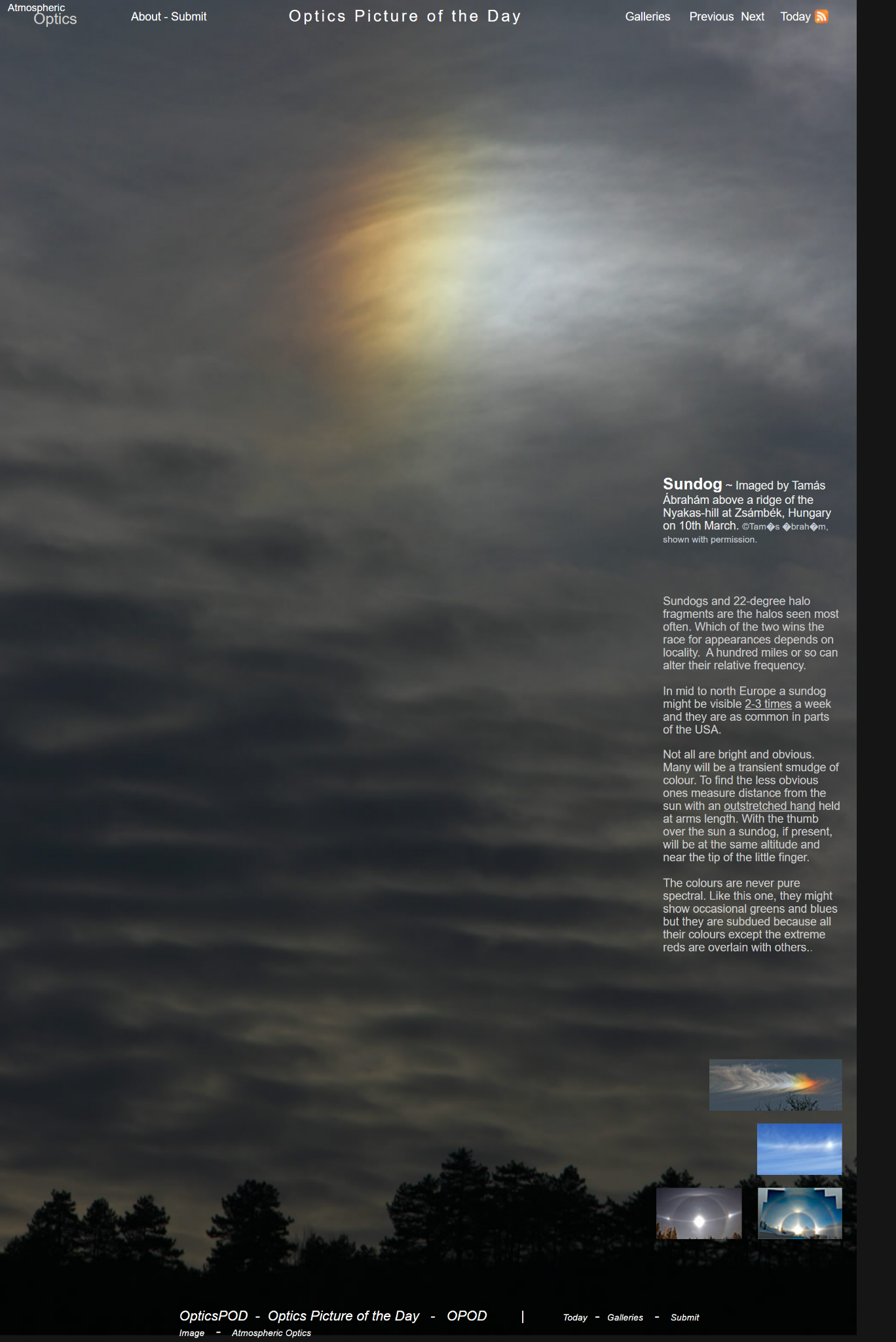Sundog
Sundogs: A Fascinating Atmospheric Phenomenon
Sundogs, also known as parhelia, are a captivating atmospheric optical phenomenon that can be observed in various parts of the world. Alongside 22-degree halo fragments, sundogs are among the most commonly seen halos in the sky. However, their frequency of appearance can vary depending on the geographical location. A mere hundred-mile difference can alter the relative occurrence of sundogs and 22-degree halo fragments.
In regions like mid to north Europe and parts of the United States, sundogs can be spotted with some regularity. In fact, in these areas, sundogs may appear two to three times a week, making them a relatively common sight for sky gazers. However, not all sundogs are equally bright and obvious. Many of them manifest as transient smudges of color, requiring a keen eye to detect.
To spot the less conspicuous sundogs, it is helpful to use a simple measuring technique. By extending an outstretched hand at arm's length and positioning the thumb over the sun, one can determine the distance of the sundog from the sun. If a sundog is present, it will be at the same altitude as the sun and will appear near the tip of the little finger.
The colors exhibited by sundogs are never pure spectral hues. While they may occasionally display hints of green and blue, these colors tend to be subdued. This is due to the fact that all the colors of sundogs, except for extreme reds, are overlain with other shades. The result is a more muted and blended palette that adds to the unique beauty of these atmospheric phenomena.
Sundogs are created through a process known as ice crystal refraction. When sunlight interacts with ice crystals suspended in the atmosphere, it undergoes refraction and dispersion. This causes the light to separate into its component colors and form a circular halo around the sun. Sundogs appear as bright spots of light on either side of the sun, approximately 22 degrees away.
The formation of sundogs requires specific atmospheric conditions. They typically occur when high, thin clouds, such as cirrus clouds, contain an abundance of ice crystals. These ice crystals act as prisms, bending and dispersing the sunlight to create the distinct halo and sundog effect. The angle at which the light passes through the ice crystals determines the size and shape of the halo.
While sundogs are most commonly observed during daylight hours, they can also occur during sunrise or sunset, adding a touch of magic to these already stunning moments. During these times, the angle at which sunlight passes through the atmosphere changes, further enhancing the appearance of sundogs.
In addition to their visual allure, sundogs have also been associated with various cultural and historical significance. Throughout history, they have been regarded as omens or signs of impending change or celestial events. In Norse mythology, sundogs were believed to be the companions of sun goddesses. They have also been linked to folklore and superstitions in different cultures around the world.
Overall, sundogs are a captivating natural phenomenon that continues to captivate sky enthusiasts and scientists alike. Whether they appear as vibrant bursts of color or more subtle smudges in the sky, these optical wonders provide a fascinating glimpse into the complexities and beauty of our atmosphere. So, keep your eyes to the sky and you may just be fortunate enough to witness the enchanting dance of sundogs in all their glory.

Sundog ~ Imaged by Tamás Ábrahám above a ridge of the Nyakas-hill at Zsámbék, Hungary on 10th March. ©Tam�s �brah�m, shown with permission.
Sundogs and 22-degree halo fragments are the halos seen most often. Which of the two wins the race for appearances depends on locality. A hundred miles or so can alter their relative frequency.
In mid to north Europe a sundog might be visible 2-3 times a week and they are as common in parts of the USA.
Not all are bright and obvious. Many will be a transient smudge of colour. To find the less obvious ones measure distance from the sun with an outstretched hand held at arms length. With the thumb over the sun a sundog, if present, will be at the same altitude and near the tip of the little finger.
The colours are never pure spectral. Like this one, they might show occasional greens and blues but they are subdued because all their colours except the extreme reds are overlain with others..
Note: this article has been automatically converted from the old site and may not appear as intended. You can find the original article here.
Reference Atmospheric Optics
If you use any of the definitions, information, or data presented on Atmospheric Optics, please copy the link or reference below to properly credit us as the reference source. Thank you!
-
<a href="https://atoptics.co.uk/blog/sundog/">Sundog</a>
-
"Sundog". Atmospheric Optics. Accessed on November 26, 2024. https://atoptics.co.uk/blog/sundog/.
-
"Sundog". Atmospheric Optics, https://atoptics.co.uk/blog/sundog/. Accessed 26 November, 2024
-
Sundog. Atmospheric Optics. Retrieved from https://atoptics.co.uk/blog/sundog/.